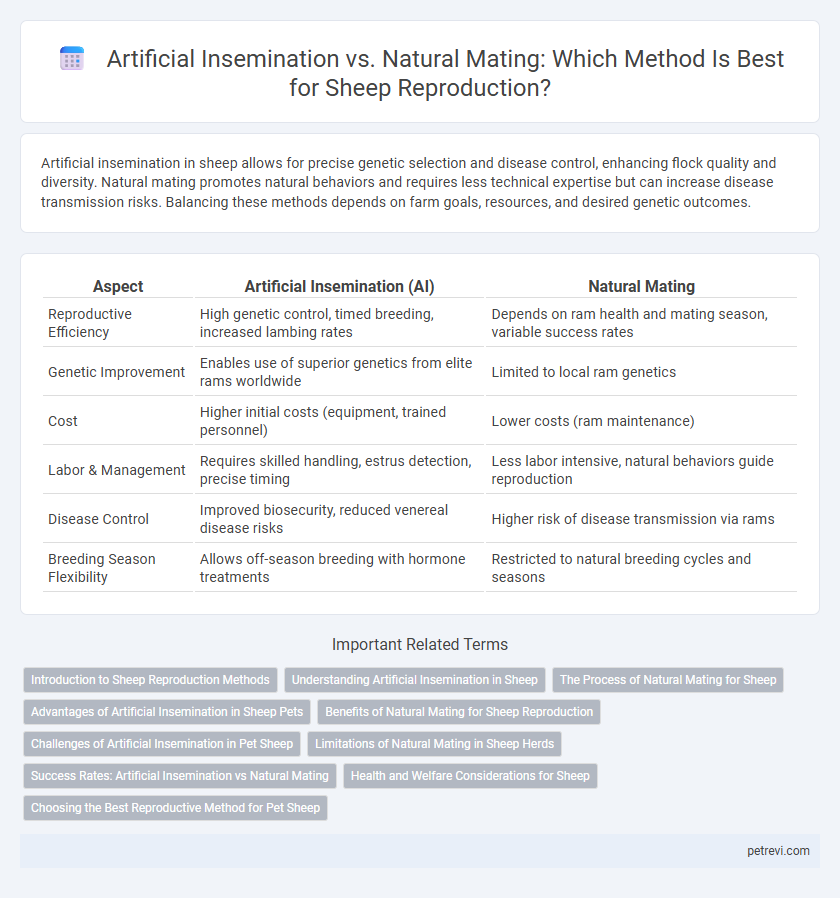Artificial insemination in sheep allows for precise genetic selection and disease control, enhancing flock quality and diversity. Natural mating promotes natural behaviors and requires less technical expertise but can increase disease transmission risks. Balancing these methods depends on farm goals, resources, and desired genetic outcomes.
Table of Comparison
| Aspect | Artificial Insemination (AI) | Natural Mating |
|---|---|---|
| Reproductive Efficiency | High genetic control, timed breeding, increased lambing rates | Depends on ram health and mating season, variable success rates |
| Genetic Improvement | Enables use of superior genetics from elite rams worldwide | Limited to local ram genetics |
| Cost | Higher initial costs (equipment, trained personnel) | Lower costs (ram maintenance) |
| Labor & Management | Requires skilled handling, estrus detection, precise timing | Less labor intensive, natural behaviors guide reproduction |
| Disease Control | Improved biosecurity, reduced venereal disease risks | Higher risk of disease transmission via rams |
| Breeding Season Flexibility | Allows off-season breeding with hormone treatments | Restricted to natural breeding cycles and seasons |
Introduction to Sheep Reproduction Methods
Artificial insemination (AI) and natural mating represent two primary methods of sheep reproduction, each with distinct advantages for flock management. AI allows for precise genetic selection, disease control, and improved lambing intervals, while natural mating offers ease of implementation and natural behavioral expression. Understanding these reproductive techniques is crucial for optimizing breeding outcomes and flock productivity in sheep farming.
Understanding Artificial Insemination in Sheep
Artificial insemination (AI) in sheep involves the controlled introduction of semen into the ewe's reproductive tract, enhancing genetic diversity and enabling selective breeding without the need for a ram on-site. This technique improves flock management by reducing the risk of disease transmission and allowing timed breeding for optimized lambing seasons. AI requires skilled handling and precise timing aligned with the ewe's estrous cycle to maximize conception rates and reproductive efficiency.
The Process of Natural Mating for Sheep
Natural mating in sheep involves direct physical contact between a ram and ewes during the estrus cycle, ensuring the ram deposits semen in the ewe's reproductive tract. This process allows for natural selection, where only the most fit rams successfully breed, potentially enhancing flock genetics. Timing is critical, as ewes are only receptive to rams during specific periods of their estrus cycle, typically lasting 24 to 36 hours.
Advantages of Artificial Insemination in Sheep Pets
Artificial insemination in sheep offers precise genetic selection, enhancing desirable traits such as wool quality and disease resistance. This method reduces the risk of transmitting sexually transmitted diseases compared to natural mating. Controlled breeding schedules through artificial insemination optimize lambing intervals and improve overall flock management in sheep pets.
Benefits of Natural Mating for Sheep Reproduction
Natural mating in sheep reproduction promotes stronger genetic diversity by allowing selective pairing based on physical traits and health. It reduces the costs associated with specialized equipment and technical expertise required for artificial insemination. Natural mating also enhances lamb survival rates through natural behavioral cues and maternal bonding during the birthing process.
Challenges of Artificial Insemination in Pet Sheep
Artificial Insemination in pet sheep faces significant challenges due to the animals' smaller flock sizes and varied genetic backgrounds, which complicate synchronization and fertility rates. The process requires skilled technicians and precise timing to achieve successful conception, often resulting in higher costs compared to natural mating. Limited availability of specialized facilities and stress-induced behavioral changes in pets further reduce the effectiveness of AI in these cases.
Limitations of Natural Mating in Sheep Herds
Natural mating in sheep herds faces limitations such as a restricted number of ewes that a single ram can service during the breeding season, which can reduce overall flock fertility rates. The risk of disease transmission and genetic defects increases due to uncontrolled breeding and close contact among animals. Seasonal breeding behaviors and physical fatigue in rams further constrain the efficiency and genetic diversity achievable through natural mating.
Success Rates: Artificial Insemination vs Natural Mating
Artificial insemination (AI) in sheep offers controlled breeding with success rates ranging from 50% to 70%, depending on factors like semen quality and timing, while natural mating typically achieves higher success rates above 80% due to natural behaviors and ewe selection. AI success improves with hormonal synchronization protocols that enhance ovulation timing, whereas natural mating benefits from flock dynamics and ram fertility. Breeders often weigh AI's genetic advantages against the generally higher conception rates and ease of natural service in sheep reproduction.
Health and Welfare Considerations for Sheep
Artificial insemination in sheep reduces the risk of disease transmission compared to natural mating, promoting better flock health. It allows for controlled breeding schedules, minimizing stress and physical injury associated with aggressive ram behaviors. However, natural mating supports natural behavioral expressions, which can enhance overall welfare when managed to prevent injury and disease.
Choosing the Best Reproductive Method for Pet Sheep
Artificial insemination offers precise genetic selection and disease control, making it a preferred choice for breeders aiming to enhance desirable traits in pet sheep. Natural mating provides a low-cost, straightforward approach with natural behavior benefits, suitable for small-scale or less intensive management. Evaluating factors such as flock size, breeding goals, and available resources helps determine the most effective reproductive method for pet sheep management.
Artificial Insemination vs Natural Mating for Sheep Reproduction Infographic

 petrevi.com
petrevi.com